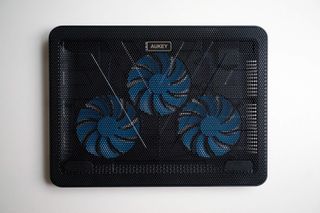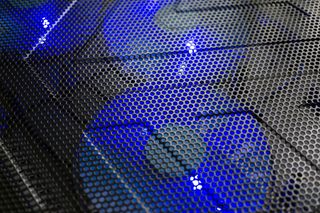This cheap Aukey Cooling Platform makes using a notebook more comfortable
Aukey is the creator of some killer accessories so we decided to take a look at the company's Cooling Platform for laptops.

We've already looked at why you may want to check out a laptop cooling pad, especially if your notebook happens to be overheating, but today we'll be looking at one solution in particular: the Aukey Cooling Platform (CP-R1, or CP-R3 in the U.S. with two fans). This rather affordable laptop cooling pad features three LED-sporting fans that spin up to 1,100 RPM in order to combat the effects of heat buildup in systems where airflow is restricted. That's the idea anyway, but how does it perform in the real world?
The Cooling Platform by Aukey is a simple product. It's simply a metal enclosure with three fans installed on the base. The top of the unit is a grill that allows for more efficient airflow. That's pretty much what most laptop coolers are in a nutshell. When it comes to the Cooling Platform, Aukey has done a great job with the build and design. As expected after using other company products, it feels sturdy enough that one shouldn't fear damage from a heavy notebook.
Two rubberized pads are located near the front of the accessory on the surface, while four are present on the underbelly for grip on a flat surface. Speaking of which, there are two foldable legs on the rear that can raise the platform at a slight angle. This is where the two pads on the top come into play, preventing the laptop from sliding around. Finally, there are vents wrapping around the sides of the pad. Overall, there are ample openings to draw throughs as much air as possible.


The three fans sport two blue LED lights, one on either side, that offer a subtle glow. As for the fans themselves, Aukey has included some quiet blowers that push out a decent amount of air (65 CFM). At just 1,100 RPM you won't be able to set this pad up on the desk and use it to cool yourself down, but it will provide just enough pressure to hit the notebook and push air into any available vents. The best part is you likely won't be able to hear The Cooling Platform on top of the noise already generated by onboard fans inside the laptop itself.
Two USB ports are available on the rear side of the cooler, sat next to a power switch. Either USB can be used to draw power from a laptop, leaving the second free port to be used as a passthrough. This is ideal if you have a limited number of USB ports initially and need to hook up multiple peripherals like a mouse and keyboard combo. And since this isn't a massive unit, it's also catering those who travel around with their laptop. At just 800g, it's lightweight and compact enough to throw into a backpack alongside even a thick notebook.


When it comes to whether or not this actually works and makes a difference, we tossed on an ASUS ZenBook, Acer Aspire S7, and even an MSI GT83-VR to take down some numbers. As you might expect, more air movement from the Aukey Cooling Platform helped to bring down the operating temperature of these laptops. It was only a few degrees at best, and some of that was no doubt to having circulation space between the laptop and my legs.
Most modern laptops are designed to handle heat effectively, but if you have one that chronically overheats (or just scorches your tender thighs), a cooler like this Aukey option has the potential to bring down the temperature by a few degrees. Other factors that affect the cooling potential of the pad include the fan and vent placement of the laptop.
Get the Windows Central Newsletter
All the latest news, reviews, and guides for Windows and Xbox diehards.

This Cooling Platform by Aukey will set you back $14.99. Included with the Aukey Cooling Platform is a USB-A to USB-A cable, the usual manual and information, as well as a card for a 2-year warranty. In the UK, this CP-R1 unit is available with a three fan setup, but in the U.S. you'll have to make do with two larger fans. Cooling performance should be on par.

Rich Edmonds was formerly a Senior Editor of PC hardware at Windows Central, covering everything related to PC components and NAS. He's been involved in technology for more than a decade and knows a thing or two about the magic inside a PC chassis. You can follow him on Twitter at @RichEdmonds.